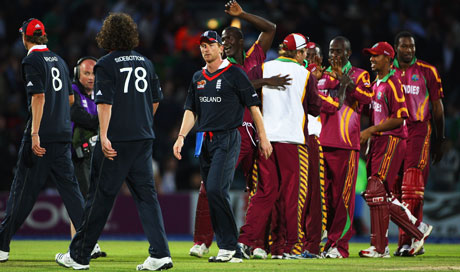Frank Duckworth: In defence of Duckworth/ Lewis
June 19th, 2009 by Sam Collins in Miscellaneous
Frank Duckworth is one of the two statisticians who developed the Duckworth-Lewis method of resetting targets in interrupted one-day cricket matches. He is a consultant statistician and the editor of the Royal Statistical Society’s monthly news magazine, RSS NEWS. He was speaking to Sam Collins.
I feel very sad that England lost to West Indies on Monday, but I don’t feel guilty. On reflection, and listening to it on a ball-by-ball basis and watching the way the West Indies were progressing towards their target and dithering, it was very, very touch and go until about two overs from the end, and the 80 set by the Duckworth/Lewis method seemed a very reasonable target.
My feeling (my partner Tony Lewis is away at a conference but I would guess he would agree with me) was that 80 from nine overs, the equivalent to nine runs an over, whereas England scored at eight runs an over, was a sufficient enhancement of the run rate to allow for the fact that West Indies would have all their wickets in hand. Wickets aren’t a great resource in a shorter form of the game; a team can lose wickets without losing much run scoring resource. The West Indies showed this, losing five wickets and still having experienced batsmen in Shiv Chanderpaul and Ramnaresh Sarwan to see them home.
Was the target too lenient? I think most people were coming to that impression with the benefit of hindsight, knowing that the West Indies made it. But they certainly didn’t make their target easily.
I’ve had a lot of media attention since the game, I don’t think there would have been so much interest had England won; it’s always of interest to the media when a match involving England is decided by the method. I think that a lot of the discussion, having listened to Test Match Special, was based on a feeling that the target was a little bit lower than it might have been. There was a suggestion that a target of 84 or 85 would have been more realistic, but West Indies were nine runs ahead of par when they won, (i.e. they were heading for about 88), they had four balls in hand and were scoring at two a ball, so even if the target had been 87 or 88 then I think West Indies would still have been favourites to win.
In all there have been 60 previous T20 matches that have involved a D/L calculation, and no one has ever queried the method or targets set before. People often ask about why targets seem to be much more proportional to overs in T20, but that is because it is a reduced game and scoring rates are higher.
In a short game, the value of wickets is less. If one looks at the par score sheet for the other day, every wicket West Indies lost just raised the par score by about one run, some by no runs at all. Wickets are not as important a resource in a much shortened game. Apart from the fact that you lose a batsman with his eye-in, the worst thing about losing a wicket is not the threat of the side being bowled out within the allotted overs, it is that it is a dot ball.
We have made one or two adjustments over the years. The original formula, which we started with back in 1997, a manual method with a set of tables based on run percentages, was drawn up using matches played between 1990 and 1995. In 2002 we did a review of the data because we had accumulated a lot more data and it was obviously more recent data. That review led us to adjust our tables slightly, and in 2004 we brought in the Professional Edition, more or less the same but adjusted to take account of higher run-rates. This Professional Edition is much more applicable to T20 with its higher scoring rates; the disadvantage is that it must be operated by computer, as no one set of tables will allow you to do the calculations.
We did a further review of the numbers used in the formula in 2005 but decided that no tweaking was necessary. We are now undertaking another review, incorporating a greatly increased set of data from T20 matches, but this was underway a long time before the match on Monday. We might make a few changes, but we might equally find that our formula still reflects the game properly at 50-over and T20 level. If we do decide to make any changes it will be in time for the start of the southern hemisphere season on October 1.
Posted in Miscellaneous | 5 Comments »

